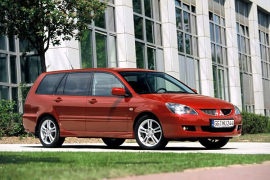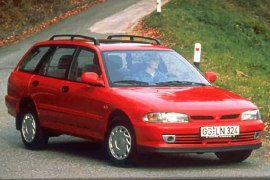
MITSUBISHI Lancer Combi
Generations Timeline, Specs and Pictures

In 2003 Mitsubishi introduced a facelifted version for the seventh Lancer, and its station wagon version received the updated package as well.
While the Lancer mainly was known for its Evolution lineup, the Japanese carmaker offered the compact vehicle in a more family-friendly version: the station wagon. Like its three-box sedan sibling, it was also available with the turbocharged all-wheel-drive system for specific markets. Still, mostly it was sold as an economical, front-wheel-drive vehicle.
The new look showed curved triangular headlights and a smiling grille split in half by a vertical slat that featured the chromed Mitsubishi badge. Its front bumper sported a wide and slim grille flanked on the sides by side-scoops for the fog lights. The Japanese carmaker built the vehicle with similar shapes up to the B-pillar, but it featured a roof extended over the trunk area, with a set of windows behind the rear doors. At the back, the tailgate was flat and vertical to maximize the interior space.
Inside, the carmaker installed a curved dashboard with a raised area for the instrument cluster. Its white dials with red needles resembled those from a sports car, even though it was just an economic station wagon. The center stack featured the CD radio and the climate control dials. At the back, Mitsubishi installed a 60/40 split-folding seatback, which expanded the trunk size from 400 liters (14.1 cu-ft) to 1,200 liters (42.4 cu-ft).
Under the hood, the carmaker installed a choice of three gasoline engines ranging between 96 hp and 135 hp. All versions were paired with a five-speed manual and sent the power to the front wheels only. The carmaker offered the Lancer Wagon in Evolution version, which pumped out up to 210 hp sent in all corners for selected markets.

Mitsubishi built the Lancer as a Colt version and evolved into a distinct vehicle range that included a coupe and a station wagon.
By 1991, the Lancer was already a known name on several markets. The Japanese carmaker introduced the station wagon in 1992, using the same platform as the Colt, but with entirely different bodywork. It wasn’t that supermini hatchback anymore but evolved into a family car.
With its narrow front end and the horizontal headlights, the Lancer Wagon/Combi featured a thin grille that sported the Mitsubishi badge in the middle and a plastic, wrapped-around bumper. On the apron, the carmaker placed a taller and broader grille to enhance the engine cooling. As a station wagon, the car featured a straight, extended roof. Its raked-forward tailgate diminished the car’s trunk but enhanced its look.
Inside, the ‘92 Lancer was the first to show rounded shapes and curved lines. Its predecessor was more on the wedged style. Its instrument panel featured a large speedometer in the middle and a tachometer on its left side. On the right dial, the carmaker installed the coolant temperature and the fuel level gauges. The center stack hosted the ventilation controls and the tape player. In the cabin, it was room for up to five adults, with a split-folding rear bench. With the seats up, the trunk could host up to 470 liters (16.6 cu-ft) of luggage, while with the rear seats folded, it increased to 1,399 liters (49.4 cu-ft).
Mitsubishi installed a choice of three engines under the Lancer Wagon’s hood, depending on the market, and paired them to a five-speed manual.

Sporting a slightly elevated ground clearance and larger cargo volume, the Combi was a practical 4 to 5 seater powered by a narrower range of engines comprised of one 1.5 L petrol unit and a 1.8 Diesel plant. The first developed 90 hp and 126 Nm of max torque and pushed the car to a top speed of nearly 106 mph via a 5-speed manual transmission while the Diesel, despite its larger displacement had a lower output of only 60 hp and drove the car to a lower top speed of well below 100 mph. Although a higher torque was expected, the engine produced a maximum torque of 113 Nm, lower than the smaller 1.5 L was capable of.























































